《无线通信理论》课程教学资源(PPT课件)Fundamentals of Wireless Communication Chapter5 Capacity of Wireless Channels
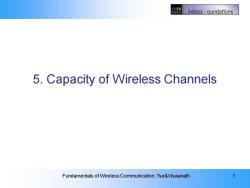
ECS Wireless oundations 5.Capacity of Wireless Channels Fundamentals of Wireless Communication,Tse&Viswanath
5: Capacity of Wireless Channels Fundamentals of Wireless Communication, Tse&Viswanath 1 5. Capacity of Wireless Channels
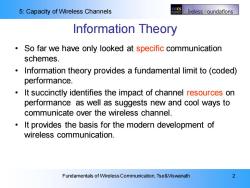
5:Capacity of Wireless Channels EECS Vireless oundations Information Theory So far we have only looked at specific communication schemes. Information theory provides a fundamental limit to(coded) performance. It succinctly identifies the impact of channel resources on performance as well as suggests new and cool ways to communicate over the wireless channel. It provides the basis for the modern development of wireless communication. Fundamentals of Wireless Communication,Tse&Viswanath 2
5: Capacity of Wireless Channels Fundamentals of Wireless Communication, Tse&Viswanath 2 Information Theory • So far we have only looked at specific communication schemes. • Information theory provides a fundamental limit to (coded) performance. • It succinctly identifies the impact of channel resources on performance as well as suggests new and cool ways to communicate over the wireless channel. • It provides the basis for the modern development of wireless communication
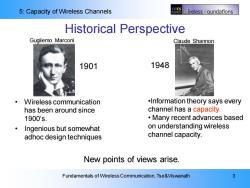
5:Capacity of Wireless Channels EECS Wireless Foundations Historical Perspective Gugliemo Marconi Claude Shannon 1901 1948 Wireless communication .Information theory says every has been around since channel has a capacity. 1900's. Many recent advances based Ingenious but somewhat on understanding wireless adhoc design techniques channel capacity. New points of views arise. Fundamentals of Wireless Communication,Tse&Viswanath 3
5: Capacity of Wireless Channels Fundamentals of Wireless Communication, Tse&Viswanath 3 Historical Perspective • Wireless communication has been around since 1900’s. • Ingenious but somewhat adhoc design techniques Gugliemo Marconi Claude Shannon •Information theory says every channel has a capacity. • Many recent advances based on understanding wireless channel capacity. New points of views arise. 1901 1948
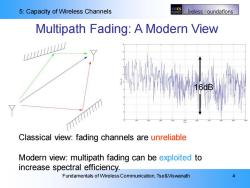
5:Capacity of Wireless Channels EECS Wireless oundations Multipath Fading:A Modern View LLL7777177777 6dB Classical view:fading channels are unreliable Modern view:multipath fading can be exploited to increase spectral efficiency. Fundamentals of Wireless Communication,Tse&Viswanath 4
5: Capacity of Wireless Channels Fundamentals of Wireless Communication, Tse&Viswanath 4 Multipath Fading: A Modern View Classical view: fading channels are unreliable Modern view: multipath fading can be exploited to increase spectral efficiency. 16dB
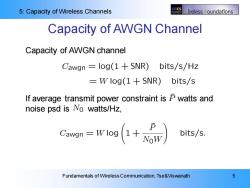
5:Capacity of Wireless Channels Vireless F oundations Capacity of AWGN Channel Capacity of AWGN channel Cawgn log(1+SNR) bits/s/HZ =Wlog(1+SNR)bits/s If average transmit power constraint is P watts and noise psd is No watts/Hz, bits/s. Fundamentals of Wireless Communication,Tse&Viswanath 5
5: Capacity of Wireless Channels Fundamentals of Wireless Communication, Tse&Viswanath 5 Capacity of AWGN Channel Capacity of AWGN channel If average transmit power constraint is watts and noise psd is watts/Hz
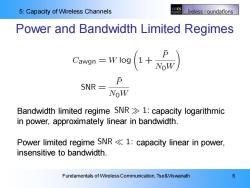
5:Capacity of Wireless Channels Vireless oundations Power and Bandwidth Limited Regimes SNR= NoW Bandwidth limited regime SNR1:capacity logarithmic in power,approximately linear in bandwidth. Power limited regime SNR<1:capacity linear in power, insensitive to bandwidth. Fundamentals of Wireless Communication,Tse&Viswanath 6
5: Capacity of Wireless Channels Fundamentals of Wireless Communication, Tse&Viswanath 6 Power and Bandwidth Limited Regimes Bandwidth limited regime capacity logarithmic in power, approximately linear in bandwidth. Power limited regime capacity linear in power, insensitive to bandwidth
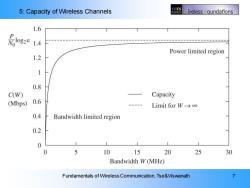
5:Capacity of Wireless Channels CS Wireless F oundations 1.6 P 1.4 Power limited region 1.2 0.8 C(W) Capacity (Mbps) 0.6 Limit for W→o∞ 0.4 Bandwidth limited region 0.2 0 0 5 10 15 20 25 30 Bandwidth W(MHz) Fundamentals of Wireless Communication,Tse&Viswanath 7
5: Capacity of Wireless Channels Fundamentals of Wireless Communication, Tse&Viswanath 7
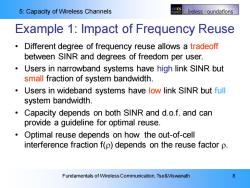
5:Capacity of Wireless Channels Vireless oundations Example 1:Impact of Frequency Reuse Different degree of frequency reuse allows a tradeoff between SINR and degrees of freedom per user. Users in narrowband systems have high link SINR but small fraction of system bandwidth. Users in wideband systems have low link SINR but full system bandwidth. 。 Capacity depends on both SINR and d.o.f.and can provide a guideline for optimal reuse. Optimal reuse depends on how the out-of-cell interference fraction f(p)depends on the reuse factor p. Fundamentals of Wireless Communication,Tse&Viswanath 8
5: Capacity of Wireless Channels Fundamentals of Wireless Communication, Tse&Viswanath 8 Example 1: Impact of Frequency Reuse • Different degree of frequency reuse allows a tradeoff between SINR and degrees of freedom per user. • Users in narrowband systems have high link SINR but small fraction of system bandwidth. • Users in wideband systems have low link SINR but full system bandwidth. • Capacity depends on both SINR and d.o.f. and can provide a guideline for optimal reuse. • Optimal reuse depends on how the out-of-cell interference fraction f() depends on the reuse factor
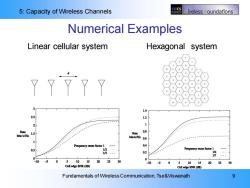
5:Capacity of Wireless Channels EECS Wireless F oundations Numerical Examples Linear cellular system Hexagonal system 14 12 Rate bite//H 0.6 Frequency reuse factor 1 0.4 0. 12 Prequency reuse factor 1 0.2 /2… 04 51015 2025 30 -10 5 0 51015 202530 Cell edge SNR(dB) Cell edge SNR (dB) Fundamentals of Wireless Communication,Tse&Viswanath 9
5: Capacity of Wireless Channels Fundamentals of Wireless Communication, Tse&Viswanath 9 Numerical Examples Linear cellular system Hexagonal system
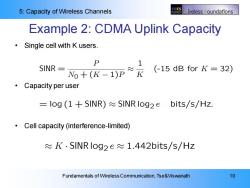
EECS 5:Capacity of Wireless Channels Wireless oundations Example 2:CDMA Uplink Capacity 。 Single cell with K users. P 1 SINR o+(K-1)P≈ (-15 dB for K=32) ·Capacity per user =log (1+SINR)SINRlog2e bits/s/Hz. Cell capacity (interference-limited) K.SINRlog2e 1.442bits/s/Hz Fundamentals of Wireless Communication,Tse&Viswanath 10
5: Capacity of Wireless Channels Fundamentals of Wireless Communication, Tse&Viswanath 10 Example 2: CDMA Uplink Capacity • Single cell with K users. • Capacity per user • Cell capacity (interference-limited)
按次数下载不扣除下载券;
注册用户24小时内重复下载只扣除一次;
顺序:VIP每日次数-->可用次数-->下载券;
- 《无线通信理论》课程教学资源(PPT课件)Fundamentals of Wireless Communication Chapter4 Cellular Systems:Multiple Access and Interference Management.ppt
- 《无线通信理论》课程教学资源(PPT课件)Fundamentals of Wireless Communication Chapter3 Diversity.ppt
- 西安电子科技大学:《无线通信理论》课程教学资源(教案讲义)Lecture 9 多用户MIMO.pdf
- 西安电子科技大学:《无线通信理论》课程教学资源(教案讲义)Lecture 8 多天线分集复用折中.pdf
- 西安电子科技大学:《无线通信理论》课程教学资源(教案讲义)Lecture 7 MIMO容量与多天线复用技术.pdf
- 西安电子科技大学:《无线通信理论》课程教学资源(教案讲义)Lecture 6 MIMO信道模型.pdf
- 西安电子科技大学:《无线通信理论》课程教学资源(教案讲义)Lecture 5 多用户容量和机会通信.pdf
- 西安电子科技大学:《无线通信理论》课程教学资源(教案讲义)Lecture 4 衰落信道容量.pdf
- 西安电子科技大学:《无线通信理论》课程教学资源(教案讲义)Lecture 3 蜂窝系统与干扰分集.pdf
- 西安电子科技大学:《无线通信理论》课程教学资源(教案讲义)Lecture 2-3 频率分集技术.pdf
- 西安电子科技大学:《无线通信理论》课程教学资源(教案讲义)Lecture 2-2 空间分集技术.pdf
- 西安电子科技大学:《无线通信理论》课程教学资源(教案讲义)Lecture 2-1 时间分集技术.pdf
- 西安电子科技大学:《无线通信理论》课程教学资源(教案讲义)Lecture 1 信道模型(主讲:郑贱平).pdf
- 《无线通信理论》课程教学资源(参考教材)Fundamentals of Wireless Communication(英文版,共八部分).pdf
- 西安电子科技大学:《信号检测与估值》课程教学资源(课件讲稿,2019)第四章 波形信号检测.pdf
- 西安电子科技大学:《信号检测与估值》课程教学资源(课件讲稿,2019)第三章 统计信号估计(主讲:郑贱平).pdf
- 西安电子科技大学:《信号检测与估值》课程教学资源(课件讲稿,2019)第二章 衰落信道上的信号检测.pdf
- 西安电子科技大学:《信号检测与估值》课程教学资源(课件讲稿,2019)第一章 高斯信道上的信号检测.pdf
- 《通信原理》课程教学资源(辅导资料)Selected MIMO Techniques and their Performance.pdf
- 西安电子科技大学:《通信原理》课程教学资源(辅导资料)Viterbi译码.ppt
- 西安电子科技大学:《无线通信理论》课程教学资源(PPT课件)Fundamentals of Wireless Communication Chapter6 Opportunistic Communication and Multiuser Diversity.ppt
- 《无线通信理论》课程教学资源(PPT课件)Fundamentals of Wireless Communication Chapter8 MIMO II:Capacity and Multiplexing Architectures.ppt
- 安徽医科大学:《单片机原理与应用》课程教学大纲(生物医学工程专业)Application and principle of single chip microcomputer.pdf
- 西门子PLC培训教程(课件讲稿,共六章).pdf
- 电子电路分析制作与调试(PPT课件讲稿)直流可调稳压电源制作与调试.pdf
- 信阳师范大学(信阳师范学院):电子信息工程专业培养方案(2019版).pdf
- 信阳师范大学(信阳师范学院):电子科学与技术专业培养方案(2019版).pdf
- 信阳师范大学(信阳师范学院):电子信息工程专业课程教学大纲汇编(2015版).doc
- 信阳师范大学(信阳师范学院):电子科学与技术专业课程教学大纲汇编(2015版).doc
- 信阳师范大学:《电工电子》课程教学资源(实验讲义,打印版)《模拟电子线路》实验讲义(共十一个实验).pdf
- 信阳师范大学:《电工电子》课程教学资源(实验讲义,打印版)数字钟电路图.pdf
- 信阳师范大学:《电工电子》课程教学资源(实验讲义,打印版)多功能数字钟电路设计《数字电子技术》课程设计指导.pdf
- 信阳师范大学:《电工电子》课程教学资源(实验讲义,打印版)《电子技术基础实验》设计性实验报告范例.pdf
- 信阳师范大学:《电工电子》课程教学资源(实验讲义,打印版)《数字信号处理》实验指导书.pdf
- 信阳师范大学:《电工电子》课程教学资源(实验讲义,打印版)《PLC原理与应用》实验课程讲义(PLC实验指导讲义S7-200,共十一个实验).pdf
- 信阳师范大学:《电工电子》课程教学资源(实验讲义,打印版)三人表决电路.pdf
- 信阳师范大学:《电工电子》课程教学资源(实验讲义,打印版)《数字电子技术基础实验》讲义——集成单稳态触发的基本应用.pdf
- 信阳师范大学:《电工电子》课程教学资源(实验讲义,打印版)TFG1900A系列函数/任意波形发生器使用指南.pdf
- 信阳师范大学:《电工电子》课程教学资源(实验讲义,打印版)数字存储示波器GDS-1000A-U示波器使用手册.pdf
- 信阳师范大学:《电工电子》课程教学资源(实验讲义,打印版)《自动控制理论》实验指导书(共十一个实验).pdf
